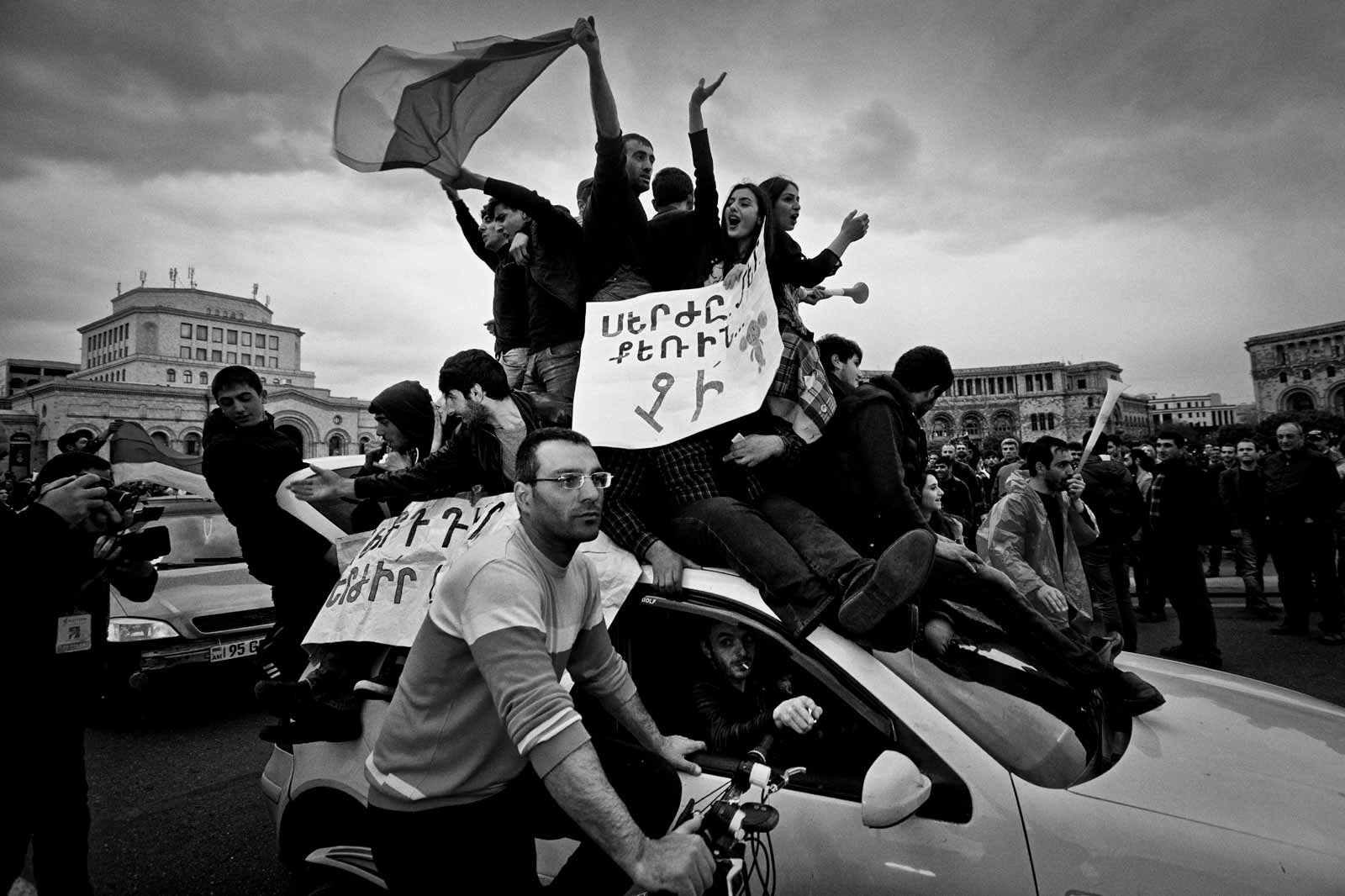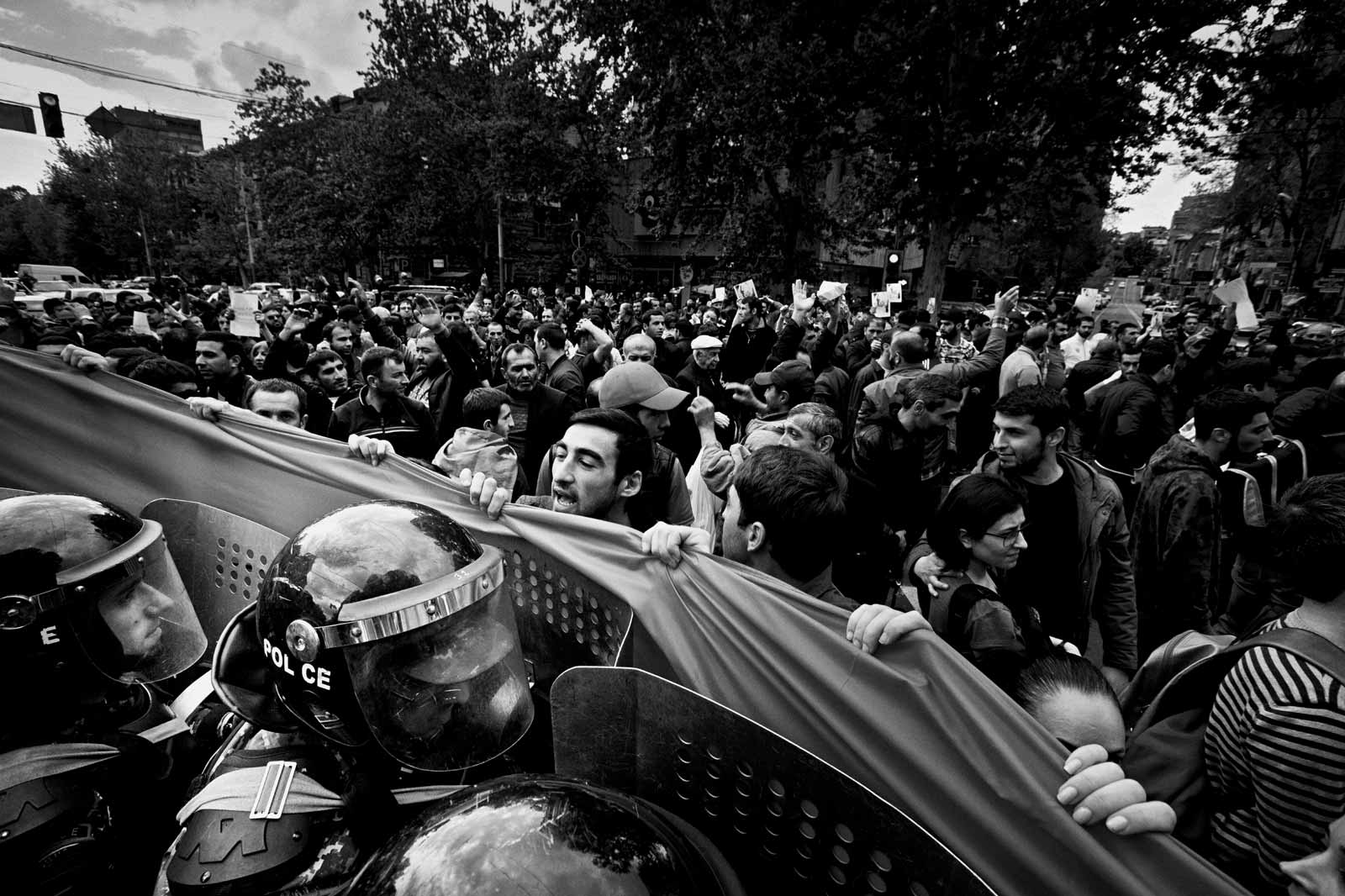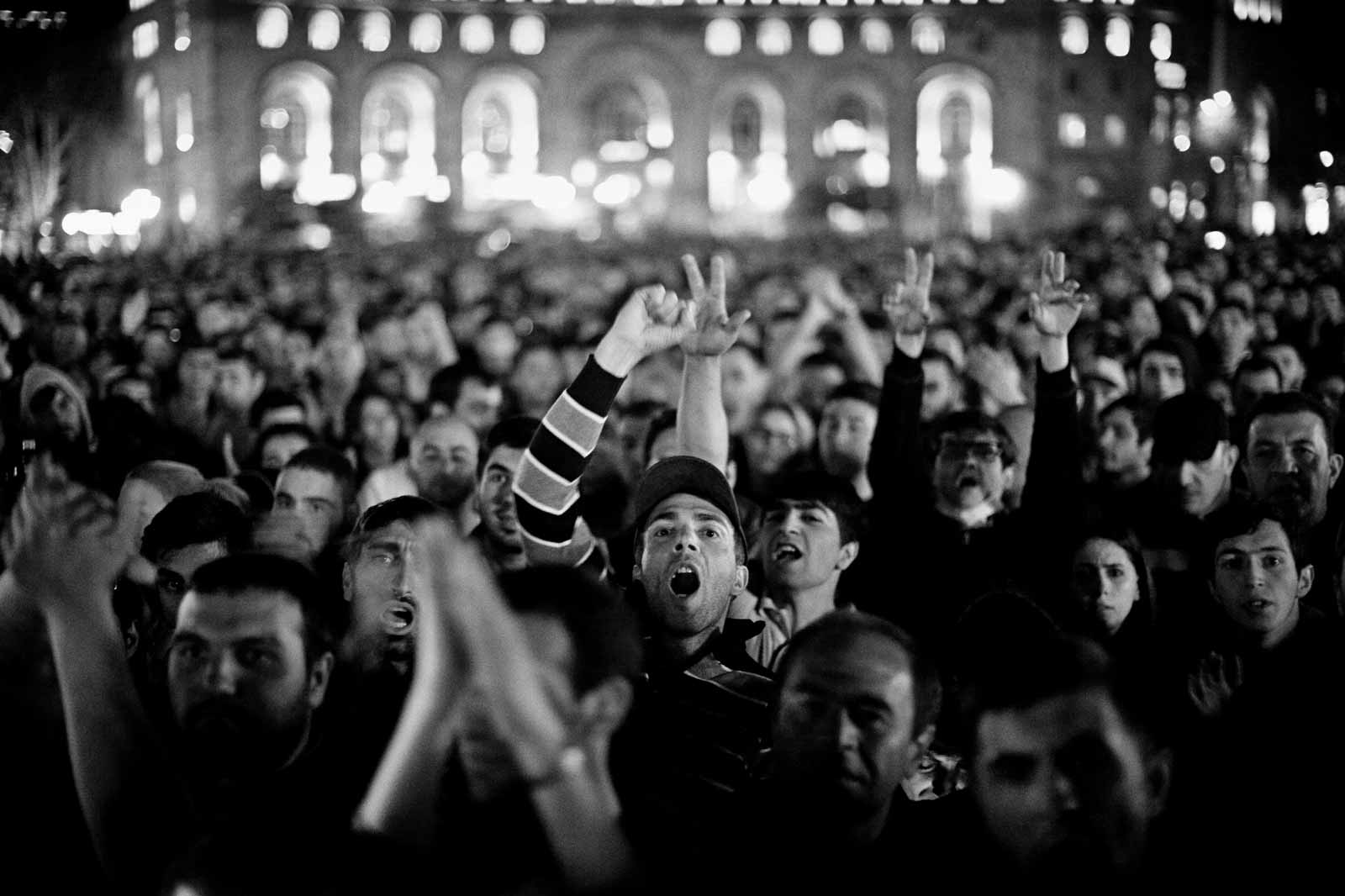Our older son, aged eight, doesn’t like protesters because they have a propensity to loiter. He also doesn’t like to be late for class. Every morning, while walking to his school bus stop, he scours the streets for plastic bags, picking them up and throwing them in a trash bin. This is a daunting task for him because it’s tough to bend down while lugging a backpack almost half his size; it’s also heavier than the world’s collective conscience.
And so, when thousands of Armenians took to the streets in recent days in what has been described as a “velvet revolution,” his first reaction was to side with the forces of order. “When will the bus arrive?” he asked. “I’m not going to make it to school on time.” A demonstrator heard him and shot back: “You shouldn’t go to school today. Come join the rally.” Our son shook his head in disagreement. “I can’t; plus, you’re dirtying the streets.” He then ran after a flying plastic bag in the middle of the intersection. “What does throwing trash have to do with anything? What is it that they want, Dad?”
What most people want is for the outgoing president not to serve as head of state for another ten years, I told him, especially considering that the last national election in Armenia, in 2017, was deeply flawed. He looked back at me, puzzled.
Back in December 2015, Armenia held a constitutional referendum to transform the government from a semi-presidential to a parliamentary system. The ruling Republican Party of Armenia (RPA), a coterie of free-market business elites, oligarchs, and allied politicians, engaged in its usual election habits of vote-buying and other irregularities to make sure the referendum passed. The object was to enable the RPA’s leader, the former president Serzh Sargsyan, to become prime minster instead, once his presidential term elapsed—which it did on April 9 this year.
The RPA and Sargsyan must have studied the playbook of Russian President Vladimir Putin. In 2008, Putin was constitutionally barred from serving a third consecutive term as president, so he assumed the role of prime minister under his protégé Dmitry Medvedev, who became president for just one term, after which Putin was re-elected president.
Sargsyan’s attempt to extend his decade-long rule, now as prime minister, met a different fate. Tens of thousands of peaceful demonstrators who opposed RPA’s near-monopoly on power took to the streets in the capital Yerevan, last month, blocking major thoroughfares with benches and other makeshift barricades. The Republicans issued a boilerplate warning that it would be politically shortsighted to continue to test the government’s patience. But a large swath of the population did not want to see Sargsyan stay in power for another ten years, and the protests continued. Under the RPA, the unemployment rate is stuck at nearly 20 percent, and close to a third of the population lives under the poverty line.
Our son issued his own admonition, more dogged than the Republicans in his demand. “I don’t want to wait any longer,” he said. “I’m going to be very late for school.” It’s true, we were twenty minutes behind schedule, and for an eight-year-old, that’s an eternity, the equivalent of twenty years in opposition.
I was proud of our son’s fealty to his school and learning, and I wanted to spare him my childhood experience in the Middle East. Just when I was learning the intricacies of prime numbers, bombs exploded in Beirut and my family was forced to move to Los Angeles, nine months into the Lebanese civil war. In elementary school, my homeroom teacher threatened to flunk me for not being able to enunciate the difference between bed sheet and bed shit. While my accent has improved, the scars from the war remain.
After I escorted our son to his school bus, I walked up an eerily quiet avenue named after a Soviet military marshal. Rows of riot police shielded the presidential palace and the parliament near the American University, where I teach a course on politics in comics. There was something sardonic about this excessive show of force in a near-empty street named after a commander who had led the Red Army to fight the Nazis in the Baltic republics, and not against his own people.
We had just finished reading Persepolis in class, Marjane Satrapi’s graphic memoir about growing up under two tyrannical regimes in Iran: first the Pahlavi dynasty, then Ayatollah Khomeini’s theocracy. Next on our reading list was Riad Sattouf’s The Arab of the Future, about a child growing up in Libya and Syria under two strongmen, Muammar Gaddafi and Hafez al-Assad. Assad was also president and prime minister, though he was prime minister for only a year, and ruled as president for twenty-nine.
Advertisement
Sargsyan is of a different breed to Assad. He is a member of a quasi-oligarchic, nationalist party with wide support in the military. While his government refrained from a draconian crackdown, the Republicans have lacked legitimacy among the population for a long time. An OSCE report documented that election-rigging and outright vote-buying were rampant in the 2013 presidential election.
On April 17, it took me fifty minutes longer than usual to reach the university. I accompanied a group of professionals traipsing up a narrow side street to circumvent the barbed wire. Hundreds of riot police were equipped with a great deal of intimidating gear, including batons, shields, and body armor. We took a narrow street behind the constitutional court that led up to the university. As we walked by, one of the women in our group addressed a high-ranking officer. “Be nice to our boys,” she said. The soldier flashed back a wave of his truncheon—and a smile: “If they don’t touch us, we won’t touch them.”
I finally made it to the university and spent much of the day thinking about how I’d pick up our son from school. He takes the school bus in the morning and we usually return by metro late in the afternoon, but the stop on the avenue named after the war commander was shut down.
After my last class at the university, I walked with one of my students to the nearest open metro station. The city center had come to a stop. Demonstrators and riot police had blocked off major thoroughfares with benches, barbed wire, and cars. The sky was an unruffled blue. There were no runty Ladas or hefty Range Rovers around. One could actually breathe and hear birds chirping. My student asked if the rallies would grow. I believed they would: Armenia’s mass protest movement using tactics of peaceful civil disobedience—among its participants were many of my students—manifests a new collective will against the forces of control. We finally reached Friendship Station and I descended into its dark marble bowels to catch a train to the school.
On the train ride home, our son started to read a graphic memoir by Guy Delisle set in North Korea called Pyongyang. I was reminded of the part about the twenty-two-meter bronze statue of the cult commander Kim Il-Sung, who, despite his death in 1994, is the state’s “eternal president.” The train roared past a station called the Factory District, where the carcasses of bygone industries once stood.
We got off at Youth Station. Every time we step into Youth Station, our eight-year-old sits down on the escalator to the dismay of a metro officer in a green uniform. She sits in a Soviet-era control booth with a landline telephone that defies most definitions of youth. When she sees him sitting down on an escalator step, she fires a stern broadside through a loudspeaker: chi gareli, “It’s not allowed.”
These words, chi gareli, are deeply embedded in the country’s psyche: you are not supposed to challenge the status quo because doing so can cause great instability to the system, and so Armenians must coalesce around the government, even if it means having a premier running the country beyond two terms—with life expectancy only increasing.
My son waved back to the middle-aged metro officer with a defiant smile. Outside, we blended into a group of protesters, many of them in their teens and twenties, blocking an intersection. It had been not quite nine hours since I had dropped him at the bus station, but he had reassessed his view of the situation on the ground. “I wish the government would ban plastic bags,” he said. We bent down and picked up a couple of errant bags. Democracy starts from the ground up.
Back home, my wife resisted another, much younger activist who had brazenly dropped a vase in the middle of our living room to protest restraints on his Tintin watching time. It had, admittedly, been a terrible week for hegemony. I put aside the quotidian obligations of parenthood and took up my patriotic duties of nationhood. After our boys went to bed, I headed to Republic Square.
The confrontation between Sargsyan and the street movement reached a boiling point on Sunday, April 22. A highly anticipated meeting between the opposition leader, Nikol Pashinyan, and the prime minister lasted minutes, and within hours the opposition leader had been detained at a local police station. That night, the rallies swelled to more than 100,000, as demonstrators poured into the streets. On April 23, unarmed soldiers joined the rallies. Pashinyan was released and, within hours, the prime minister had resigned. It was the day of our younger, glass-smashing son’s fifth birthday. The gift was unexpected.
Advertisement
It seems that Armenia might now have a chance of getting a more responsive and accountable government. Although the Republicans are still entrenched in parliament and control fifty-eight of the 105 seats, they have lost a coalition partner. On May 1, following a nine-hour debate in parliament, the Republicans blocked Pashinyan from becoming prime minister. But the protests have already broken the frozen pattern of power. The psychology of “it’s not allowed” has been turned on its head.





